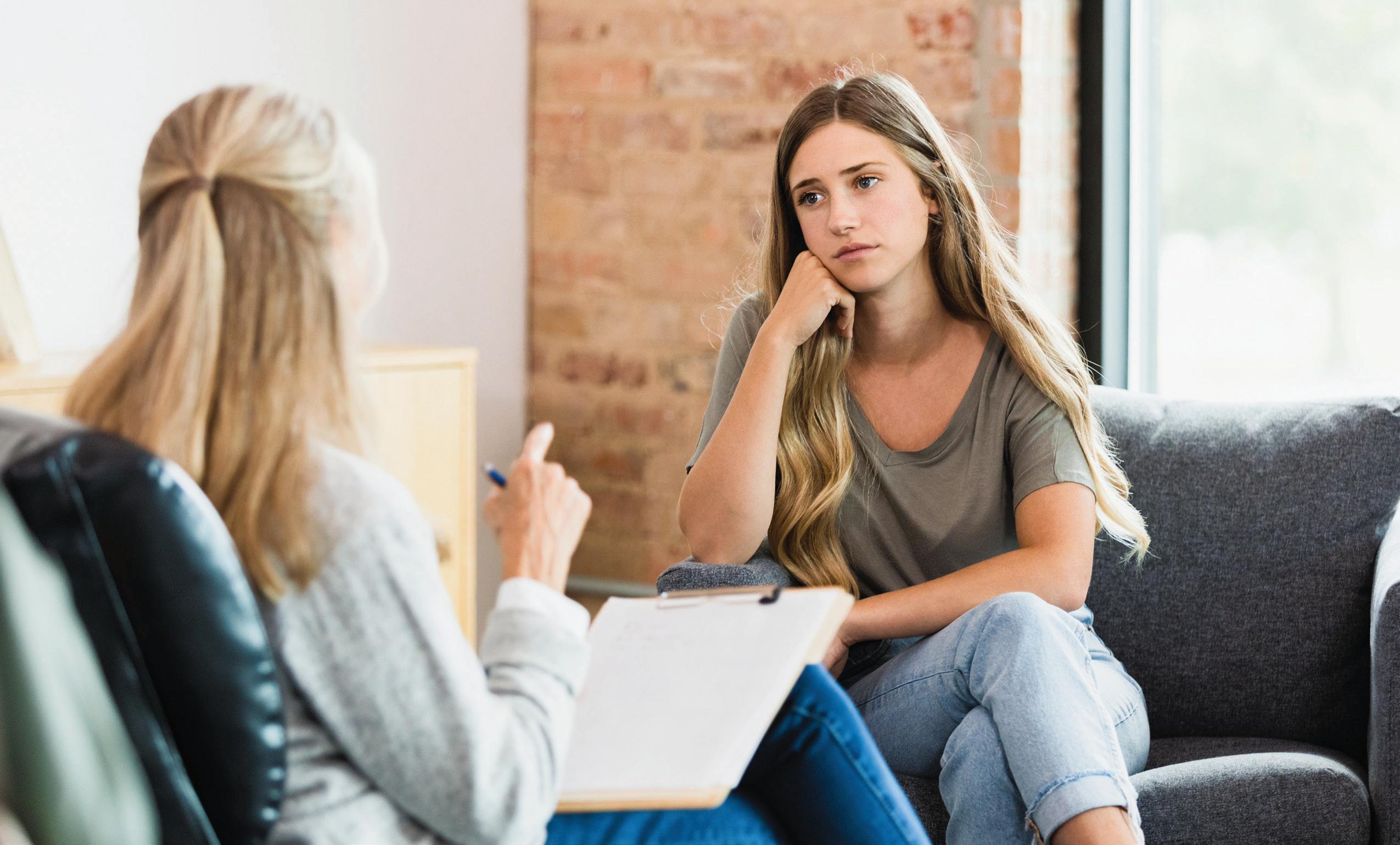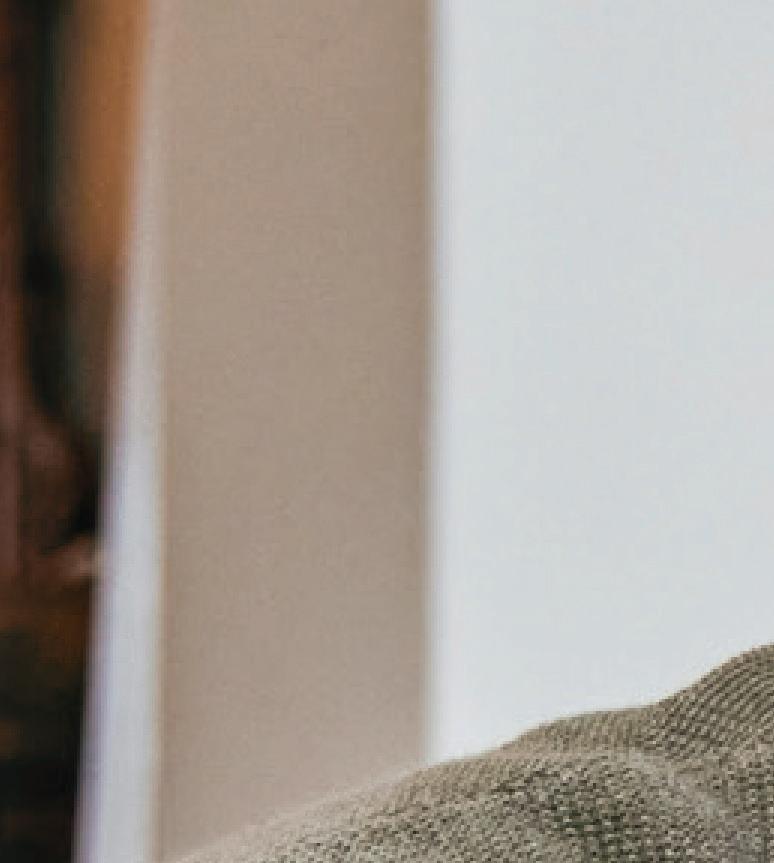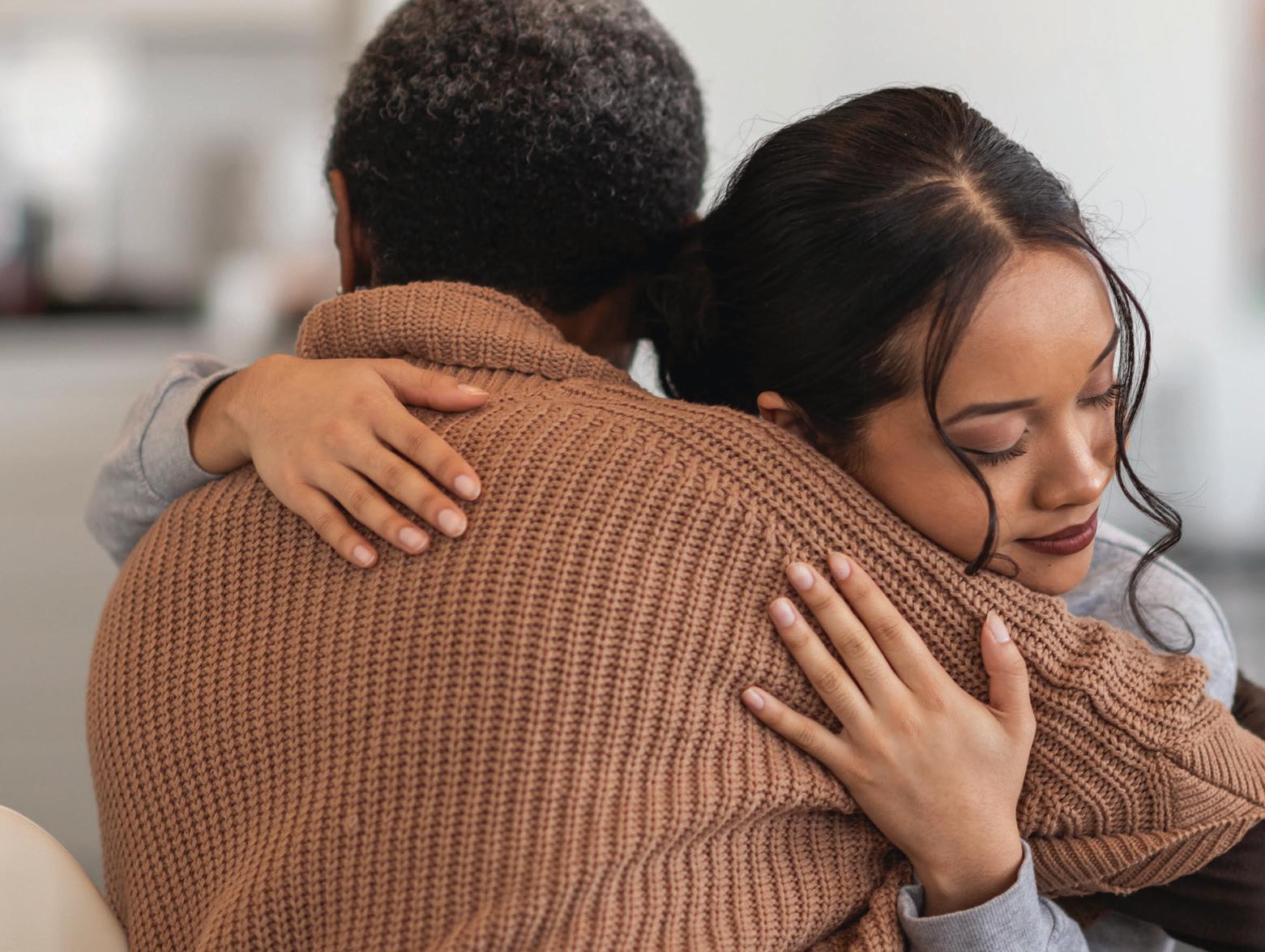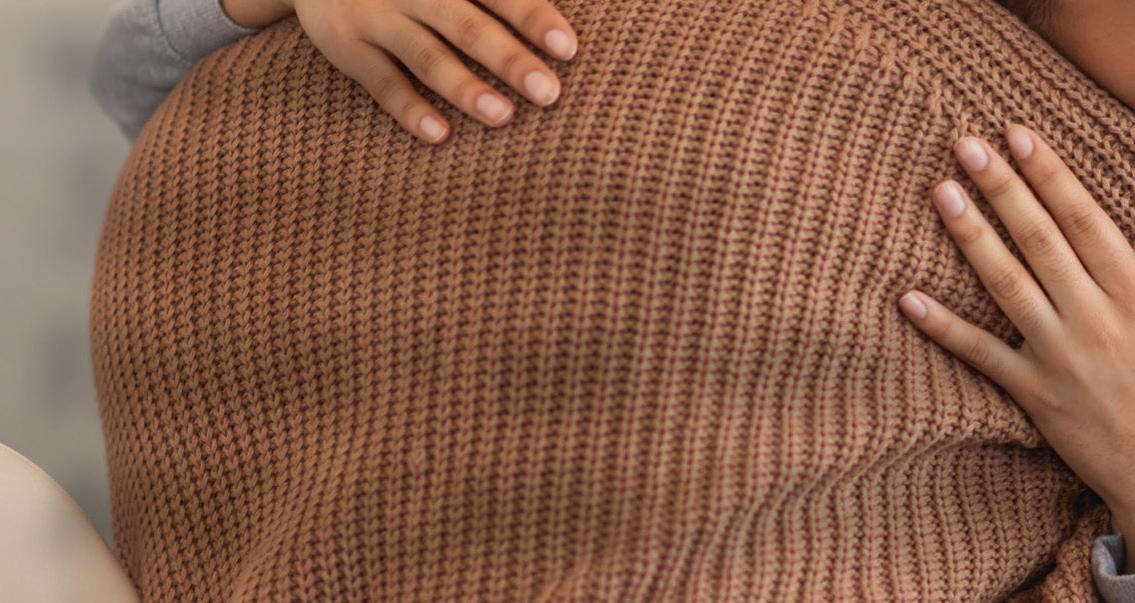









































































































































































































































































































































































































































AT HOME EATING RECOVERY AND PATHLIGHT A MAGAZINE FOR MENTAL HEALTH PROFESSIONALS | WINTER 2023 TREATING TRAUMA THE EATING DISORDER THAT’S OFTEN OVERLOOKED WHEN IS VIRTUAL IOP COVERED? VIRTUAL THERAPY How to Maximize
3 WELCOME MESSAGE
Dr. Anne Marie O’Melia answers clinicians’
common questions about telebehavioral health care 4 7 EVIDENCE-BASED REASONS VIRTUAL IOP WORKS
What the data shows about patient experiences, attendance and outcomes 6 THE MENTAL HEALTH CRISIS ON CAMPUS
How campus providers are supporting students today
COHESION: THE KEY TO EFFECTIVE GROUP THERAPY
Best practices for fostering patient connections, whether in person or virtually

BUILDING CONFIDENCE IN TREATING TRAUMA
Helping you offer specialized trauma treatment for your patients 12
BINGE EATING DISORDER
The most common eating disorder, yet often unrecognized and undiagnosed
WINTER 2023 COVER
CHANCES ARE, YOUR PATIENT IS COVERED
Experts help you and your patients successfully navigate insurance coverage at higher levels of care
EXPOSURE THERAPY AT HOME EXCEEDS EXPECTATIONS
How virtual eating disorder exposure therapy can be integrated into everyday life 18 ONE FAMILY’S STORY
How virtual IOP gave this family the tools they needed to support their daughter’s recovery 20 TIPS FOR SUPPORTING FAMILY MEMBERS AND CAREGIVERS
How to empower caregivers and spot the signs of burnout 21 WHAT WE’VE LEARNED FROM 7,000+ VIRTUAL PATIENTS
Eight ways for patients to get the most out of virtual sessions


Illustration by Vanessa Branchi
©2023
Recovery Center, Inc. All rights reserved.
8
10
Contents
Eating
14
16
21 4 14 Connect With Us Eating Recovery Center Eating Recovery Center @EatingRecovery @EatingRecovery Pathlight Mood & Anxiety Center Pathlight Mood & Anxiety Center @PathlightBH @PathlightBH To subscribe, visit www.ERCPathlight.com/Subscribe WINTER 2023 | Eating Recovery and Pathlight AT HOME 2
Anne Marie O’Melia, MS, MD, FAAP she/her/hers
Chief Medical Officer and Chief Clinical Officer, Eating Recovery Center and Pathlight Mood & Anxiety Center
Virtual care is changing the way we think about behavioral health care. It increases access to care and allows us to truly meet people where they are, in their everyday lives, with their everyday stressors and supports. Since 2016, we have seen the impact of our virtual intensive outpatient treatment model. We have come to believe that, for many people, expert and specialized virtual care is key to sustainable recovery.
We are confident that it’s here to stay. That’s why we’re excited to announce that we’ve changed the name of our proven virtual intensive outpatient program (IOP) to Eating Recovery and Pathlight At Home. As our new name suggests, we’re offering the same expert treatment we provide on-site from the comfort and convenience of home.
As I travel around the country, clinicians frequently ask for more information about virtual behavioral health care. Here are some of the questions I hear most often.

How do you evaluate whether virtual treatment is effective?
A number of meta-analyses have shown online and in-person therapy to be equally effective.1 That tracks with our own research at Eating Recovery Center (ERC) and Pathlight Mood & Anxiety Center (Pathlight). We continually study the results of Eating Recovery and Pathlight At Home, our virtual IOP, and we have published peer-reviewed research. Our patient data shows clinically significant improvements in all outcomes measured, including self-reported eating disorder symptoms, depression, self-esteem, quality of life and overall satisfaction. See page 4 to learn more about the effectiveness of telebehavioral therapy.
How do patients truly find connection to each other and their clinicians in a virtual setting?
As clinicians know, group cohesion is a key factor in successful outcomes. The way we achieve cohesion in our virtual model is all about having a small, core group of patients and providers who meet regularly. Each member is part of a group where attendance is taken, participation is expected and people are held accountable. This milieu mirrors the experience of on-site group therapy. That’s how we develop what I call a “healing community” online. See page 8 to learn more about group cohesion.

Does insurance cover virtual IOP?


7,000+
Our team of clinicians has treated more than 7,000 patients in our virtual programs so far.
When we first began virtual IOP, insurance companies didn’t cover it. However, the silver lining of the pandemic was that virtual health care of all kinds became widespread and yielded tons of data. Now, Eating Recovery and Pathlight At Home is covered by most commercial carriers. See page 14 to learn more about insurance coverage.
As a child psychiatrist and pediatrician, I’m passionate in my belief that the longer and better we can support our patients in their everyday lives, the greater their chance for permanent change. My team of clinicians has treated more than 7,000 patients and their families in our virtual programs so far. I’m confident in their expertise and in their ability to partner with you to treat your patients.

1. Seymour, M. (2022). Does online therapy work? National Center for Health Research, Washington, D.C.

CONTACT US
To learn more, call 1-877-825-8545 or visit www.EatingRecovery.com/AtHome or www.PathlightBH.com/AtHome
A Message from
3 Eating Recovery and Pathlight AT HOME | WINTER 2023
7 EVIDENCEBASED REASONS VIRTUAL IOP WORKS
While telebehavioral health became ubiquitous during the pandemic, it is not widely known that virtual intensive outpatient treatment has been available through ERC Pathlight since 2016. To date, more than 7,000 patients have received virtual treatment at Eating Recovery and Pathlight At Home. By 2023, the program is expected to be available in nearly all states around the country. Clinicians and patients considering a virtual intensive outpatient program (IOP) should know that a program based on best clinical practices and evidence-based treatments, in conjunction with longstanding clinical experience, can be highly successful—and ERC Pathlight has data to confirm program efficacy based on patient outcomes, which is collected at the initiation and completion of treatment. The overall patient experience is evaluated alongside symptom endorsement, patient engagement and program completion rates. “We use this important clinical data to inform our standards of excellence in the quality of patient care,” says Deborah Michel, PhD, CEDS-S, FAED (she/her/hers), National Clinical Director at Eating Recovery and Pathlight At Home.
Based on our research, clinicians can feel confident about recommending Eating Recovery and Pathlight At Home, our virtual IOP, which delivers exceptional patient experience and outcomes. Here’s what we’ve learned.
1
Virtual IOP participation results in symptom reduction.
Results showed statistically significant and clinically meaningful improvements in body dissatisfaction, binge eating, cognitive restraint, purging, restricting and excessive exercise for those in the eating disorders program. In addition, there were statistically significant improvements in depression and anxiety when pre-admission was compared with postadmission. These findings are based on data obtained from 882 Eating Recovery and Pathlight At Home patients completing the Eating Pathology Symptoms Inventory (EPSI) before and after treatment between January 2021 and December 2021.
2
Patients are highly engaged with virtual IOP. Several statistics indicate higher engagement rates in virtual than in on-site IOP. We have seen a more than 25% increase in program completion for virtual IOP versus on-site IOP.1 We also see close to 90% attendance rates in the virtual program, which is slightly higher than attendance rates in on-site IOP.
3
Patients build strong connections to one another in a virtual setting.
“As a clinician, you’re trained in what to look for when you’re sitting in an office with a patient,” says Casey Tallent, PhD (she/her/hers), Director at Eating Recovery and Pathlight At Home. “What we’ve found in virtual therapy is that being so close to a patient’s face, you see visual cues—a lip quivering, eyes blinking—that you might miss from across the room.” In our virtual IOP pilot study, all patients surveyed said they felt

What the data shows about patient experiences, attendance and outcomes
WINTER 2023 | Eating Recovery and Pathlight AT HOME 4
connected to facilitators and group members, and we’ve continued to see patients report these strong connections.
4


Virtual IOP is covered by many insurance plans.

Eating Recovery and Pathlight At Home is in-network with nearly all major commercial insurance providers. “During the COVID-19 pandemic, insurers had to cover virtual IOP and fortunately they witnessed how well it works and vowed to continue coverage,” says Dr. Tallent. The Patient Access Team works closely with insurance companies and patients to help them understand coverage and to advocate for patients with insurers.
5
Virtual IOP is effective for children and adolescents.
“This generation of children and adolescents has been living in the virtual world for quite some time, and they are comfortable in it,” says Dr. Michel. A preliminary evaluation of admission and discharge assessments for children and adolescents participating in our virtual eating disorders program reported statistically significant and clinically meaningful improvements on all clinical measures, including cognitive restraint, eating concerns, shape concerns and weight concerns [Eating Disorder Examination Questionnaire (EDE-Q), n=218], as well as in depression [Patient Health Questionnaire-9 (PHQ-9), n=217] and anxiety [General Anxiety Disorder-7 (GAD-7), n=84].1
Patient Outcomes
Virtual IOP patients showed tremendous progress in their pathology symptoms after 30 days in treatment.
0.8 0.7 0.6 0.5 0.4 0.3 0.2 0.1 0 -0.1 -0.2 Body
Baseline 30 days
• From January 2021 to December 2021, 882 patients recorded 143,344 entries in a proprietary app regarding their mood, urges and meals.

• Patients reported clinically significant improvements in body dissatisfaction, binge eating, cognitive restraint, purging, restricting, and excessive exercise during virtual IOP.
skills groups available each week. Parent/ caregiver nutritional counseling sessions with registered dietitians occur weekly to assist parents/caregivers with meal planning and portioning for the child or adolescent.
7

Virtual treatment enables more intensive family-based treatment (FBT) than many in-person programs.

6
Care is well coordinated with the outpatient team. In many cases, patients may continue to meet with their outpatient providers while in virtual IOP, particularly toward program completion. Most insurance plans will cover both when clinical services occur on different days.
about outpatient team coordination of services agree that virtual IOP staff effectively coordinate with other service providers. Outpatient providers also report being very pleased with the communication received from the Eating Recovery and Pathlight At Home team.
“The key to our success with children and adolescents is the family support system, and virtual IOP makes it easy to incorporate that,” says Dr. Michel. Virtual treatment allows more families to participate in IOP programming, thereby supporting the FBT-informed component of IOP. A parent or caregiver is required to be at each virtual IOP meal and receives feedback on how to assist the child in completing the meal. There is a strong focus on family therapy using emotion-focused family therapy with multiple family education and
The Eating Recovery and Pathlight At Home treatment team includes a primary therapist for all programs and a registered dietitian for the eating disorder programs. Other licensed therapists may facilitate psychoeducation skills groups as well. Outpatient providers are regularly updated on patient progress and are included in their patient’s treatment planning including discharge planning. Patients surveyed
“In addition to all its other benefits, including high patient satisfaction and outcomes, virtual mental health care expands access to so many people who need treatment,” says Dr. Tallent. “If a clinician has any hesitance about referring a patient for virtual care, we encourage them to connect with our virtual treatment team to take a tour of the treatment environment and learn about our evidence-based treatments and the positive outcomes our patients have achieved.”
1.Michel, D.M., O’Melia, A.M., Mathes, W.F., & Tallent, C.N. (2022). Telebehavioral health intensive outpatient program attendance and length of treatment compared to in-person service. [Manuscript submitted for publication]
each
FREE CONSULTATION
Please contact us to make a referral or schedule a free consultation with a master’s-level clinician at 1-877-825-8584 To learn more about Eating Recovery and Pathlight At Home, visit www.EatingRecovery.com/AtHome or www.PathlightBH.com/AtHome
DissatisfactionBinge Eating
Cognitive Restraint
RestrictingExcessive Exercise
5 Eating Recovery and Pathlight AT HOME | WINTER 2023
Change in Eating Pathology Symptoms Inventory (EPSI) Z scores from baseline to 30 days Purging
The Mental Health Crisis on Campus
“W
hen I first started working in college counseling in 2005, the acuity of the mental health issues we saw was not nearly as severe as it is now,” says Casey Tallent, PhD (she/her/hers), Director at Eating Recovery and Pathlight At Home. “It has continued to increase year by year.”
For generations, college students have faced the stresses of a major life transition, maneuvering through the challenges of a new location, new roommates and new academic demands. So why does the number of students seeking mental health services continue to rise? Experts cite some of the reasons:
Return to the classroom. Getting back into a normal classroom environment can be a big adjustment for students who have been learning virtually during the pandemic, especially for those who suffer from social anxiety.
Rising cost of college. “Many students are really pushing hard to get and keep scholarships; others are working to help cover their expenses,” says Tricia BesettAlesch, PhD (she/her/hers), Director of Counseling and Psychological Services at the University of Nebraska-Lincoln (UNL).
Online distractions. “Students are finding it hard to put their phones down, and for Generation Z it’s especially difficult,” Dr. Besett-Alesch says. “The algorithms on social media platforms keep people scrolling on and on. There’s gaming, streaming services and apps at the palm of their hands. The hours go by and then they realize they’ve lost a significant amount of time, leading to more stress and anxiety.”
Preexisting issues. “About a third of the students we see have already been on mental health medication,” Dr. Besett-Alesch says. “The medication has enabled them to attend college—which wouldn’t have been the case 10 or 15 years ago—but that doesn’t mean their struggles have gone away.”
How Campus Mental Health Centers Adapt
This increased demand is coming at a time when campus mental health services are finding themselves stretched thin, as many colleges and universities may have cut counseling budgets during the pandemic. Campus counseling centers have devised

How campus providers are supporting students today
WINTER 2023 | Eating Recovery and Pathlight AT HOME 6
WHY VIRTUAL IOP SUITS COLLEGE STUDENTS
In a 2020 survey, more than 70% of students said they would utilize telebehavioral health services if they had access to them, and now, more than ever, they have options.1
“Virtual services have been a game changer for college providers, especially now that it’s covered by most major insurances,” says Casey Tallent, PhD (she/her/hers), Director at Eating Recovery and Pathlight At Home. “Not only has it opened up outpatient care, but virtual intensive outpatient programming (IOP) is helping students stay in college and student athletes continue in their sport while getting the care they need.”
Virtual IOP also offers anonymity for students who don’t want to be seen walking into a counseling center. That’s especially true for college athletes, on-campus counselors have found, because they’re dealing with a culture of perfectionism, and they can often be local celebrities.
That was the case for former NFL player Patrick Devenny, who developed bulimia when he was a star college football player. “There’s so much pressure to do well—you’ll try any crazy diet hack to make weight,” he says. “Did I want my coach to get a report that I went to a counseling center? No way—that would affect my playing time. Virtual IOP would have been an incredible opportunity for me at that time.” Now in recovery, Devenny has become a mental health advocate and is a member of the ERC Pathlight Say It Brave Collective to use his lived experience to help others and end mental health stigma.
Eating Recovery and Pathlight At Home will offer athlete-specific virtual IOP programming in 2023. For more information, visit www.EatingRecovery.com/AtHome and www.PathlightBH.com/AtHome.
a number of strategies to adapt:
Creative scheduling. “We will never tell students, ‘That’s it, we’re full,’ so we’ve had to become more innovative in scheduling,” says Dr. Besett-Alesch.
At UNL, students new to Counseling and Psychological Services are encouraged to call for an initial appointment on the same day they want it instead of scheduling weeks in advance. This has reduced the late cancellations and no-shows significantly at the center. “In a very busy period, the student still may have to call in the next day or two to get the first appointment, but they no longer have to wait weeks for that first visit like they did when we scheduled those appointments out,” says Dr. Besett-Alesch. Counselors at UNL also vary the frequency with which they see patients, seeing them once a week if possible, but switching to every other week at times of peak demand.
Help with case management/team extenders. “Case managers are worth their weight in gold,” says Karen Anderson, MD, CEDS (she/her/hers), a physician with University Health Services at Penn State in University Park, whose campus eating disorders team has seen a 100% increase in students over the course of the pandemic. “They can help a student get medicine and connect with outside resources as needed.” Dr. Anderson also hired a nurse to do regular vital signs checks and weighins, freeing up her own time to see more patients.
Additional resources. Free resources for students are widely available. In-person and virtual support groups are offered by colleges, nonprofits and other organizations, including ERC Pathlight. Mental health awareness programs like ERC Pathlight’s “Say It Brave on Campus” series help reduce stigma and provide education to students,
SUPPORT FOR CAMPUS PROFESSIONALS
To learn more about our specialized health center and athletic and counseling department training, email: Caitlyn.Lange@ERCPathlight.com.
Check out our on-demand mental health courses:
Navigating the Mental Health Crisis on Campus
Speakers: Casey Tallent, PhD and Jennifer Moran, PsyD CE Hours: 1
Treating Eating Disorders and Mental Health in College Athletes
Speakers: Amy Gooding, PsyD and Ralph E. Carson, PhD, RD, CEDRD CE Hours: 1
To access these courses, visit www.ERCPathlight.com/ CECoursesOnDemand, enter your information and use the code Magazine22.
resident advisors, athletic departments and other campus organizations.
Mental health treatment, including telebehavioral therapy, is widely covered by most commercial insurance, but it takes effort to identify partners who are knowledgeable about the needs of college students and who can help with more acute cases. Available across the nation, Eating Recovery and Pathlight At Home is a proven virtual intensive outpatient program.
For all the challenges of increased demand, the fact that students are seeking help is a good thing. “Increased utilization of our services is telling us that students are recognizing that they need help and taking steps to get the support they need,” says Dr. Besett-Alesch.
1. The JED Foundation. (2020). Survey of college student mental health in 2020: Summary of findings. October 22, 2020
7 Eating Recovery and Pathlight AT HOME | WINTER 2023
COHESION: The Key to Effective Group Therapy

Research definitively shows that cohesion— the unity or solidarity of a group—leads to better outcomes in group therapy settings.
“Group cohesion is based on three factors: the individual’s relationship with their therapist, their relationship with other members and their relationship with the group as a whole,” explains Deborah Michel, PhD, CEDS-S, FAED (she/ her/hers), National Clinical Director at Eating Recovery and Pathlight At Home. “These personal attachments foster empathy, trust and accountability.”
However, shaping that therapeutic milieu is both a skill and an art. “Group therapy is hard, and experience managing group dynamics varies widely among clinicians,” says Anne Marie O’Melia, MS, MD, FAAP (she/her/hers), Chief Medical Officer and Chief Clinical Officer at ERC Pathlight. “Knowing that, we ensure that our clinicians have extensive resources, education
and supervision, provided by nationally and internationally known experts.” Those resources are available to support both in-person intensive outpatient program (IOP) and Eating Recovery and Pathlight At Home, our virtual IOP, which ERC Pathlight has offered since 2016.
Connecting Virtually



Peer support and connection, which are key to cohesion, are as effective in a virtual setting as they are in person, according to ERC Pathlight’s expert clinicians. “We know that best practices involve continuity, both in the group cohort and the patient’s care team,” says Dr. O’Melia. “An important component of a care model that helps people recover is building and maintaining quality in all of these relationships. These relationships form online much like the way they form in person.”
Over time, group members become invested in the success of the other members. “Peer support leads to accountability,” says Dr. O’Melia. “For example, let’s say you have trouble getting out of bed in the morning, and in the group session you say you’re going to start setting your alarm for 7 a.m. Yes, it’s important for the therapist to help with that. But it lands differently when your peers ask you about it, because they understand exactly how hard it can be to get out of bed when you just don’t want to.”
Eating Recovery and Pathlight At Home therapists have found that having around nine people in a virtual group (including the therapist) is optimal for virtual engagement. “We picked that number because having nine faces on a screen allows the photos to be large enough that people can see each other’s expressions,” says Dr. O’Melia.
To further help patients connect with each other, the program provides experiential activities, such as a cooking class for an eating disorders group, or an on-screen game for a mood and anxiety group.
“Another advantage to virtual therapy is providing people with support in their everyday lives at home,” says Dr. O’Melia. “We truly get to see what their healing environment is like.”
What Patients Should Know



Patients who may be hesitant about virtual group therapy can be reassured that the treatment team will work closely with the patient’s outpatient providers, including their therapist and primary care provider, to ensure continuity of

ERC Pathlight experts’ best practices for fostering patient connections, whether in person or virtually
WINTER 2023 | Eating Recovery and Pathlight AT HOME 8
THE THREE LAYERS OF GROUP COHESION
MEMBER TO MEMBER MEMBER TO LEADER MEMBER TO GROUP
CONSISTENCY COUNTS:
THE EATING RECOVERY AND PATHLIGHT AT HOME APPROACH TO VIRTUAL IOP GROUP THERAPY
• The care team, including individual therapist, group therapist and dietitian (for eating disorder patients), is consistent throughout treatment.
• All experts on the care team are licensed.
• Members of the peer group are generally consistent throughout the treatment; it is not a drop-in model.
• A structured, evidence-based curriculum is followed.
• The curriculum includes psychoeducational groups and processoriented psychotherapy groups, which are conducted by seasoned clinicians.
“These are the three important factors for establishing and maintaining group cohesion to support a healing environment,” says Anne Marie O’Melia, MS, MD, FAAP.
treatment. In addition, virtual therapy lends itself well to the involvement of family members, including those in different locations.
Moreover, the virtual group provides valuable insights that are helpful for individual therapy. “We can think of the group as a microcosm: how you relate there is reflective of how you relate in the world,” says Dr. Michel. “For example, is the patient emotionally disengaged in a group because their social anxiety is so high? If so, the therapist can work with the patient on an individual basis to discuss their social anxiety, teach coping techniques and practice social skills in the group setting.”
“Outpatient providers as well as patients should understand that virtual IOP can head off worsening outcomes that lead to residential care or partial hospitalization,” says Dr. O’Melia. “Virtual IOP can also support a patient after they’re discharged from a higher level of care, helping them maintain the skills they learned while they were away.”
Most importantly, patients should know that Eating Recovery and Pathlight At Home clinicians have the expertise to ensure that virtual group therapy is meaningful for each member. Says Dr. Michel, “We know how to bring a group together in such a way that everyone has an equal voice, feels safe, and feels connected.”
• Groups are small to allow formation of therapeutic alliances.
• Members of a patient’s outpatient team are integral to the “care village” and work closely with Eating Recovery and Pathlight At Home experts.
• Research has shown a correlation between treatment length and positive outcomes.1 The average treatment duration of virtual IOP is eight weeks; this is over 15% higher than on-site treatment duration. 2
• Attendance rates for virtual IOP are nearly 90%, slightly higher than those for on-site IOP. 2 Consistency in therapy attendance has been linked to positive outcomes.3

BUSTING MYTHS ABOUT VIRTUAL ENGAGEMENT

Many assume that virtual treatment doesn’t result in the same level of connection among patients and their group. Our data says otherwise.
LEARN MORE
To
100%
of patients surveyed felt connected to facilitators and group members.4 98% agreed that staff created a recovery-focused environment.4 97%
feel treatment has increased their chances of improving their health.4
1. American Psychological Association, Division 12. (2017). Clinical Practice Guideline for the Treatment of Posttraumatic Stress Disorder, How long will it take for treatment to work?

2. Michel, D.M., O’Melia, A.M., Mathes, W.F., & Tallent, C.N. (2022). Telebehavioral health intensive outpatient program attendance and length of treatment compared to in-person service. [Manuscript submitted for publication]

3. Zimmerman, E.L. (2019). The effect of inconsistent therapy attendance by client and therapist on therapeutic outcomes. Doctoral dissertation, Brigham Young University
4. Blalock, D.V., et al. (2020). Pilot assessment of a virtual intensive outpatient program for adults with eating disorders. European Eating Disorders Review, 28(6), 789-795
To learn more about Eating Recovery and Pathlight At Home, visit www.EatingRecovery.com/AtHome and www.PathlightBH.com/AtHome Please contact us to make a referral or schedule a free consultation with a master’s-level clinician: 1-877-825-8584 or fax: 425-974-1530. Most commercial insurance accepted.
9 Eating Recovery and Pathlight AT HOME | WINTER 2023
BUILDING CONFIDENCE in Treating Trauma
ERC Pathlight can help you offer targeted treatment for your patients
About half the population will experience at least one traumatic event in their lifetime.1 Yet clinicians often take a “too-careful approach” to treating it, according to research published in the European Journal of Psychotraumatology. 2 One major reason is a fear of causing additional harm to their patient.

“Therapists are often seeing these patients for other conditions, such as depression or an eating disorder, and they may fear a patient may be too fragile to discuss past trauma and its effects,” says Kim Anderson, PhD, CEDS (she/her/ hers), East Executive Director at ERC Pathlight. “The therapist’s instinct is to want to stabilize the patient first.
As a result, trauma treatment is sometimes delayed and delayed, and, ultimately, in some cases, it may never be addressed.”
Specialized Trauma Training
In addition, a therapist may avoid treating trauma symptoms because they lack training in this area. “However, once a clinician is trained in empirically supported treatments, with good supervision, they will find treating trauma no more overwhelming than any other disorder they’re working with,” says Dr. Anderson. “At ERC Pathlight, we use cognitive processing therapy, known as CPT, and also trauma-focused cognitive behavioral therapy, or TF-CBT. Both are first-line, evidence-based treatment modalities that work well in conjunction
with other treatment approaches we’re using for depression or general anxiety.”
“Trauma can often be a tricky diagnosis,” notes Kelly Souza, PsyD, CEDS (she/her/ hers), Clinical Lead at ERC Pathlight. “Many of its symptoms—such as rage, substance abuse, being withdrawn—overlap with depression, anxiety, bipolar disorder and other mental health diagnoses.”
Spotting the Symptoms
Trauma-related symptoms tend to fall into four clusters, says Dr. Souza:
Avoidance: steering clear of memories, people and locations related to the trauma
Hyperarousal: physiological reactions, such as concentration or sleep problems or being easily startled
WINTER 2023 | Eating Recovery and Pathlight AT HOME 10
Intrusive Symptoms: nightmares, flashbacks



Negative Moods: self-blame, extreme fear, guilt, anxiety
“Because these symptoms are seen in a number of conditions, it’s important that intake assessments include screening for trauma, whether for outpatient therapy or a higher level of care,” Dr. Souza says.
ERC Pathlight provides free assessments by master’s-level clinicians and trauma-informed care for patients at all levels, including inpatient, residential, partial hospitalization and intensive outpatient care (on-site and virtual). “We then partner with outpatient providers on their essential role on the treatment team throughout the admissions process, treatment and discharge,” Dr. Souza says. “This collaboration throughout the patient’s journey ensures the continuity of care they need.”
Treating Trauma: Evidence-Based and Effective
The treatment modalities ERC Pathlight uses to treat trauma are forms of cognitive behavioral therapy:
Cognitive Processing Therapy (CPT): More than 23 controlled trials have demonstrated that CPT is effective in decreasing trauma-related symptoms. “With CPT, the patient doesn’t have to relive and focus on the details of the traumatic event,” says Dr. Anderson. “Instead, we ask them to describe their thoughts or beliefs about


the experience. Then we identify what we call ‘stuck points’ that contribute to the perpetuation of trauma reactions.”





To “interrupt” negative thoughts, the therapist will ask a series of Socratic questions. “You’re checking the facts, questioning the evidence, helping the patient look at the experience in different ways so they can find a different meaning in it,” Dr. Anderson says.
Trauma-Focused Cognitive Behavioral Therapy (TF-CBT): “This approach is more appropriate for younger patients and, unlike CPT, includes family members,” explains Dr. Souza. “Similar to CPT, we’ll examine what the patient is telling themselves about the trauma and decide whether those things are true or not, at an age-appropriate level.” In the course of treatment, the child learns coping skills for stress-related emotions and behaviors, and family members develop skills to support the child.

The long-lasting effects of trauma are hard to overstate. However, our experience has shown that, with a trauma-informed approach and the right treatment, patients can learn the skills and tools they need to recover.
1. National Center for Posttraumatic Stress Disorder. (2022). How common is PTSD in adults? U.S. Department of Veterans Affairs
2. Gielen, N., Krumeich, A., Havermans, R.C., Smeets, F., & Jansen, A. (2014). Why clinicians do not implement integrated treatment for comorbid substance use disorder and posttraumatic stress disorder: A qualitative study. European Journal of Psychotraumatology, 5, 10.3402/ejpt.v5.22821
THE ROLE OUR TRAUMA TRACK PLAYS IN TREATMENT
Pathlight Mood & Anxiety Center offers expert trauma treatment in our residential and partial hospitalization programs. This specialty track works to break down the impacts of trauma, helping patients understand the impacts of trauma, address trauma-related beliefs and rebuild their lives.
THE TRACK’S BENEFITS
• Cognitive processing therapy (CPT) is a foundational, firstline, evidence-based psychotherapy to treat the symptoms of PTSD in addition to traumafocused cognitive behavioral therapy (TF-CBT)
• Collaborative treatment planning with the patient and caregivers

ERC PATHLIGHT CAN HELP
To make a referral or schedule a free assessment with a master’s-level clinician at ERC Pathlight, call 1-877-825-8584
• A multidisciplinary team with strong collaboration between psychiatric and psychotherapy approaches
Expand Your Knowledge on Treating Trauma Today 1. Attend our free on-demand CE courses, including “Treating Trauma,” with Kim Anderson, PhD, CEDS and Albert Tsai, MD www.PathlightBH.com/OnDemandCECourses 2. https://cptforptsd.com: Hosted by treatment co-authors Patricia Resick, PhD, Kate Chard, PhD and Candice Monson, PhD 3. www.TFCBT.org: National Therapist Certification Program 4. www.PESI.com: A source for continuing education 5. www.TraumaInformedCare.chcs.org: Trauma-Informed Care Implementation Resource Center of the Center for Health Care Strategies 11 Eating Recovery and Pathlight AT HOME | WINTER 2023
It’s been more than four years since Dave Vrablik had a binge eating episode, but he remembers them all too well. Two to three times a week, he would go to a fastfood restaurant or chain steakhouse alone and eat supersized meals.

“All my life, I dealt with trauma or adversity or any kind of issue by going to food,” he recalls. “It was the one thing I could rely on.” The food made him feel better, temporarily. Relief was followed by extreme physical discomfort and a vow to never do it again. Hours or days later, the cycle would begin anew.
The devastating sudden death of a beloved older brother exacerbated his binge eating behaviors. It took a tearful plea from his wife and an intervention by his father and a good friend to send Vrablik to an eating disorders treatment program for the help he needed.
“I can remember walking through those doors and not knowing what I was walking into,” he recalls. “I had never even heard of binge eating disorder.” He was in ERC’s partial hospitalization program seven days a week for seven weeks. “My treatment at ERC saved my life,” he says.
A Hidden Disorder
Binge eating disorder (BED) is the most common eating disorder—as many as 7 million people in the U.S. will struggle with it over the course of their lifetime1 but also one of the most underdiagnosed. “Many clinicians aren’t familiar with BED, perhaps because it has only been in the DSM since 2013,” 2 says Kate Barse, PsyD (she/her/ hers), Clinical Leadership at ERC.
Clinicians often miss BED diagnoses because of assumptions they make based on a person’s body size. A clinician may not think to ask a person living in a smaller body about the behaviors that characterize BED. Conversely, we know that eating disorders are more often missed in people living in marginalized bodies due to cultural and weight stigma as well as implicit or explicit bias. “For patients in larger bodies, the focus too often shifts to weight loss and starting a diet, rather than assessing whether there’s an eating disorder,” explains Dr. Barse.
There also can be patient-related barriers to identifying BED, such as feelings of shame or a lack of understanding that they have an illness that is treatable.
BINGE EATING DISORDER
Assessing for BED
Clinicians should actively invite conversation around food and behavior, Dr. Barse advises. “We can take a nonjudgmental stance and invite folks into a low-risk conversation,” she says. “Some questions you can ask are, ‘How is your relationship with your body? How much time do you find yourself spending thinking about food, planning around it, focusing on eating it? Is it distressing to you?’” Phrases that should raise red flags are those alluding to compulsive eating, such as
“I can’t help it” or “I feel like I have to,” Dr. Barse says.
In addition, regular extended periods of restriction, such as regularly skipping breakfast and being “too busy” for lunch, can be a sign that a person is trying to make up for binge eating episodes.
“There are numerous biological and psychosocial risk factors for BED including a history of trauma, dieting, a family member with an eating disorder and heritability, among others. Mood and anxiety disorders
The most common eating disorder, yet often unrecognized and undiagnosed
WINTER 2023 | Eating Recovery and Pathlight AT HOME 12
FREE ONLINE SUPPORT FOR BED
ERC offers virtual support groups for binge eating, which are open to anyone. Prior treatment at ERC is not required. Scan the code to register.
LEARN MORE
behavioral therapy and acceptance and commitment therapy can all be effective modalities for treating BED.”
ERC has treated thousands of patients with BED for more than 10 years, becoming one of the largest, leading BED treatment providers in the U.S., including both in-person and virtual treatment.
A unique feature of our virtual binge eating disorders program at Eating Recovery At Home is that it takes place in a separate milieu, that is, not in a mixed group that includes patients with restrictive eating disorders. Patients report that they feel more comfortable in a separate milieu and are better able to share their experiences with others who have similar food behaviors and body image concerns. Through this specialized programming, patients learn inclusive and mindful eating, dismantle diet culture expectations, gain confidence in preparing and cooking meals and, most importantly, find freedom from shame and guilt.
The nutrition approach to BED treatment is more flexible than the approach for people with restrictive eating disorders. “We have guidelines, but not rigid rules around eating, and we don’t exclude specific foods. We plan, prepare and eat meals together,” explains Hannah Gruenewald, MS, RD, LD (she/her/hers), Clinical Nutrition Manager at ERC.
Vrablik can vouch for the effectiveness of ERC treatment. “Community was one of the most important elements of getting treatment for my binge eating disorder and continues to be throughout my recovery journey,” he says.

are highly correlated with BED as well,” says Dr. Barse.
ERC’s Unique Approach
With the appropriate information, a clinician can proceed to diagnosis and the creation of a holistic treatment plan. “We recommend that BED be treated by an eating disorders specialist and a registered dietitian,” Dr. Barse says. “At ERC, we’ve found that evidence-based therapies such as cognitive behavioral therapy, dialectical

Vrablik now has his own company as a motivational speaker. “I actually came up with the idea for my business while I was sitting in a room at ERC,” he recalls. “They helped me recapture my authentic life. Now I want to help others have a chance at a new beginning.”
1.Deloitte Access Economics. (2020). The social and economic cost of eating disorders in the United States of America: A report for the Strategic Training Initiative for the Prevention of Eating Disorders and the Academy for Eating Disorders. June 2020.

2. Marx, R. (2022). New in the DSM-5: Binge eating disorder. National Eating Disorders Association.
 Dave Vrablik has worked his way from BED patient to motivational speaker helping others create their own new beginnings.
Dave Vrablik has worked his way from BED patient to motivational speaker helping others create their own new beginnings.
the code to find out more about Eating
At Home’s specialized program
binge
13 Eating Recovery and Pathlight AT HOME | WINTER 2023
Scan
Recovery
for
eating disorders.
CHANCES ARE, YOUR PATIENT IS COVERED



LEARN MORE
Scan this code to watch a series on navigating insurance by Cyndi Eddington. Advocate for mental health parity with your local representatives today at www. thekennedyforum.org





Thirty-five years ago, when Cyndi Eddington, retired Vice President of Revenue Cycle Management at ERC Pathlight, accepted her first job in mental health, she knew she had found the right field. “I loved what I was doing,” she says.


Decades later, she saw firsthand how important having access to mental health care can be. Not long after she joined ERC Pathlight in 2012, Eddington learned that her daughter, then 18, needed care for an eating disorder. A few years later, her youngest son needed care for an anxiety condition.





“I was fortunate to understand insurance and obtain benefits that let me access incredible professionals who could support my kids,” she says. “But I realize not many people who require mental health coverage for themselves or a loved one have that level of knowledge.”
Eddington built what she calls a “Financial Treatment Team” at ERC Pathlight. Its goal: to



















bridge the gaps between providers, payers and patients. “The team is passionate about sharing what we’ve learned about navigating insurance for mental health care,” Eddington says. “We feel like it’s our pay-it-forward moment.”





























Coverage Expands







A profound shift in mental health coverage occurred in 2008 with the passing of the Mental Health Parity and Addiction Equity Act. It required mental health coverage to be no more restrictive than insurance coverage for other medical conditions.


The initial act applied only to group health plans. But the passing of the Affordable Care Act in 2010 extended mental health parity to individual health insurance coverage too.1
However, virtual therapy at higher levels of care, which utilize a milieu or group therapy model, was not yet covered. “While mental



























ERC Pathlight can help you and your patients navigate insurance coverage to get them the treatment they need today
WINTER 2023 | Eating Recovery and Pathlight AT HOME 14
health parity created widespread coverage for intensive outpatient programs (IOP), virtual IOP was considered an alternative method of care and was excluded,” Eddington explains.
That changed during the COVID-19 pandemic, when virtual health care became widespread and the federal government, state Medicaid programs and private insurers expanded coverage for telehealth. 2 “Payers learned during the pandemic that IOP could be provided effectively through telehealth services,” Eddington says. “Now, with few exceptions, Eating Recovery and Pathlight At Home, our virtual IOP, is covered by all major carriers.”
One of the most significant benefits of coverage for virtual IOP is the way it expands access to mental health services to people in rural areas.
“I grew up in a small town in Minnesota. It was at least a 500-mile drive into Minneapolis to get specialty services, like treatment for an eating disorder,” Eddington says. “Now, with the increase in virtual IOP coverage, people can get the very best care for eating disorders and other mental health conditions no matter where they live.”
Virtual IOP as Preventive Care
Sometimes providers hesitate to refer to virtual IOP because they believe a payer won’t authorize a patient for the treatment until that patient’s health condition reaches a more advanced stage.


From a clinical standpoint, however, the best time to refer a patient to Eating Recovery and Pathlight At Home is as soon as it’s clear that the patient is not making progress in outpatient care and requires additional support. “The sooner we can deliver care to someone during their illness, the higher the probability they will have a sustained recovery,” Eddington says.
She recommends that providers rely on ERC Pathlight to help them overcome insurance questions or barriers to referrals. “If open questions are causing you to defer potential early intervention into a higher level of care, lean on us,” she says. “We understand if a patient will meet the standard of medical necessity and we’ll help you and your patient through the authorization process.”
Advocates for Patients and Providers
Providers who choose to refer a patient to Eating Recovery and Pathlight At Home will get guidance at every step. Most often, providers will initially talk with an admissions coordinator who will manage the pre-authorization process, which includes scheduling an assessment with an ERC
FREE CONSULTATION

3
TIPS FOR REFERRING PROVIDERS
How can you help your patients make a seamless transition into Eating Recovery and Pathlight At Home (virtual IOP)?



1


ASSUME THE BEST. Know that virtual IOP is covered by nearly all payers.


ASK FOR HELP. If patients express any concerns about high deductibles or co-insurance, the ERC Pathlight Financial Treatment Team can offer patients financial counseling and payment plans.


2

3 BE A GUIDE. Remind patients to have their insurance card ready when they talk with ERC Pathlight. Even better? Make the call along with the patient to create the best transition possible.
Pathlight master’s-level clinician. The assessment results will determine the recommended level of care for the patient and will give payers the information they require to complete insurance payment authorization.
During and after treatment, the Financial Treatment Team will help ensure accurate adjudication of covered services on behalf of the patient.
Knowing that patients who need virtual IOP already face multiple stressors, Financial Treatment Team members see themselves as patient advocates. “We understand that our assistance makes an incredible difference in the lives of families and patients because they’re in a difficult place right now, unable to take in a lot of the complexity,” Eddington says. “When someone is advocating for you to get the best financial outcome, it makes an impact.”
1.U.S. Centers for Medicare & Medicaid Services. (2022). The Mental Health Parity and Addiction Equity Act (MHPAEA)
2. Health Resources and Services Administration. (2022). Billing for telehealth during COVID-19. U.S. Department of Health and Human Services
To learn more about what coverage your patient has, call us at 1-866-247-2591 For quick reference on insurance topics, visit www.EatingRecovery.com/Insurance or www.PathlightBH.com/Insurance
To


15 Eating Recovery and Pathlight AT HOME | WINTER 2023
EXPOSURE THERAPY AT HOME Exceeds Expectations
Exposure therapy is a core component of treatment for a number of mental health issues, including eating disorders.
Based on its experience of treating more than 7,000 patients virtually, ERC Pathlight has now made exposure therapy a key part of its Eating Recovery At Home virtual intensive outpatient program (IOP).
“When a patient is in a higher level of care for eating disorders on-site, they’re in a highly structured environment, surrounded by therapeutic support,” explains Kaila PeakRishel, LCSW, LMFT, CEDS-S (she/her/ hers), Clinical Director of Child & Adolescent Services at Eating Recovery and Pathlight At Home. “The beautiful thing with virtual IOP is that we’re able to loop in their support system at home, and the support person can help the patient use those skills when we’re not there.”
“What I love as a clinician is that virtual IOP allows us to leverage the true exposures of patients in day-to-day life,” says Kristie Simmons, MS, RD, CEDRD-S (she/her/hers), Nutrition Director at Eating Recovery and Pathlight At Home. “It helps them create a setting in their home environment that supports their recovery.”
How It Works
Exposure treatment can be used for most eating disorders, including anorexia, binge eating disorder and avoidant restrictive food intake disorder.
“We have each patient create a hierarchy of feared foods or activities on a scale of one to ten from least to most anxiety provoking. We start at the lower end of the hierarchy and work our way up as patient mastery progresses. This provides an opportunity for the patient to build tolerance and

With virtual IOP, eating disorder exposure therapy can be embedded in everyday life
WINTER 2023 | Eating Recovery and Pathlight AT HOME 16
FROM EATING DISORDER TO FINDING THE JOY IN FOOD
Chef Emily Hersh developed anorexia and binge eating disorder during her college years. During intensive outpatient treatment at the ERC location near her home, she had a revelation: “I realized that whatever I did in my eventual career, I wanted to be able to help people who are struggling,” she says. She was delighted by a cooking class she attended while receiving treatment at ERC. “Everyone was laughing and having so much fun. It was the first time I’d felt really passionate in a long time.”
Cooking is now Hersh’s career. She’s done virtual cooking classes for ERC support groups and has created a YouTube series called The Self-Help Chef. She also recently helped open Pure Grit BBQ, a plant-based fast-casual restaurant in New York City, and acted as Culinary Director and Executive Chef.
“I’m open about my story because I hope it will resonate with people who are struggling in secret with their eating disorder,” Hersh says. “They need to know that help and a community are available for them. And when you face your eating disorder headon, you feel invincible—like a warrior!”
FIND CHEF EMILY HERSH
Scan this code to watch her video series The Self-Help Chef.
Scan this code to make her delicious Spicy & Smokey Black Bean Bang Bang Burgers.

confidence to be able to move further up the hierarchy,” explains Deborah Michel, PhD, CEDS-S, FAED (she/her/hers), National Clinical Director at Eating Recovery and Pathlight At Home.
Eating Recovery and Pathlight At Home exposure treatment is based on exposure and response prevention (ERP), which is the gold standard for obsessive compulsive disorder treatment and has also been found highly effective for eating disorders. ERP sessions consist of the patient and a therapist and/or a registered dietitian. A family member or other support person may also be present.
“For example, at a session I might say ‘Let’s do a binge exposure with chips’ and ask them to rate the level of their anxiety,” says Peak-Rishel. “What works best for patients in ERP is direct prompts: ‘Open the cupboard, pull out the bag of chips and take one bite’ or ‘Just open the cupboard and look at the bag of chips,’ depending on what stage the patient is at.”
The therapist will periodically check in with the patient about their anxiety level. When the number is half of what the original number was, the session wraps up with a debrief on the patient’s experience.
“You want the patient to be doing this

type of exposure within their support system multiple times a week, even multiple times a day if appropriate,” Peak-Rishel says. “It’s a lot of work, but it’s fast moving if the patient is motivated to work on it.”
ERP can be done in conjunction with other evidence-based modalities used for coexisting conditions. Cognitive behavioral therapy challenges the patient’s thoughts, dialectical behavior therapy teaches coping skills to soothe the nervous system and acceptance and commitment therapy deals with choosing behaviors that fit our values. “And of course, family therapy is a critical intervention for any eating disorder, because mental illness doesn’t happen in a vacuum,” Peak-Rishel says.
Addressing Food Fears
Dietitians and therapists work as a team in virtual IOP. “While the therapist focuses a bit more on the cognitive aspect, the dietitian specializes in the experiential pieces—what I


call the nuts and bolts,” Simmons says.
Each patient gets weekly one-on-one time with their dietitian, where they receive education and discuss challenges they’re facing. Patients also make and eat meals together virtually with the regular members of their pod.
With the appropriate HIPAA and patientsafety protocols in place, a dietitian can even “go along” with a patient as they face their fears, for example, being present for support on the phone if a patient goes to a bakery, buys a croissant and takes it back to their car to eat.
“We tailor whatever we do to that particular individual,” Simmons says, “with the goal of allowing them to get back to a free and flexible life.”
“Virtual exposure treatment can really be the equivalent of, if not better than, in-person care,” she says. “It’s been a real perspective shift for our field, and I’m excited to see where this goes as we all learn more. It can only be good for patients.”
LEARN MORE
Read more at www.EatingRecovery.com/exposure-therapy
17 Eating Recovery and Pathlight AT HOME | WINTER 2023
ONE FAMILY’S Story
Tia S. suspected something wasn’t right with her 16-year-old daughter, but she wasn’t sure what was bothering her. Then one day her daughter “Jane” (name changed to protect her anonymity) was found unconscious in a neighbor’s yard after she collapsed during a run. This incident led to an ER visit, subsequent medical testing and eventually a diagnosis of an eating disorder.
The news was a shock, but Tia and her husband mobilized right away. They learned all they could and assembled the
full outpatient care team that had been recommended. After six months, however, Jane wasn’t showing improvement.
Increasingly alarmed, Tia and her husband requested another assessment. Jane received a recommendation for a partial hospitalization program (PHP) with ERC, in which she would participate in ten hours of intensive therapy seven days a week. Jane would then spend nights at home to practice the skills she’d learned in an independent but supervised manner. The family traveled to another city, and
her father arranged to work remotely for the duration of the treatment program.
Nine weeks later, Jane was cleared for discharge from PHP, with the recommendation that she and the family participate in Eating Recovery At Home, ERC’s virtual intensive outpatient program (IOP).
“I had big reservations about virtual therapy,” Tia recalls. “Because of her learning style, my daughter hadn’t done well with virtual learning during the pandemic. And although we as parents had

How Eating Recovery At Home gave these parents the tools they needed to support their daughter’s recovery
WINTER 2023 | Eating Recovery and Pathlight AT HOME 18
learned important skills ourselves in the program, I wasn’t at all sure how we would handle the challenges with our daughter back at home.”
Jane’s experience in Eating Recovery At Home inspired Tia to advocate for the benefits of virtual programming for families. Her daughter has maintained weight restoration, is repairing her relationship with her younger siblings and is back at school.
“I would advise any family to be open to virtual IOP. It provided essential support for our daughter’s transition home,” Tia says. “I can’t imagine what we would have done without it.”
Individualized Care
Tia was reassured when the Eating Recovery At Home care team took the lead. “They reached out to us on day one,” she says. “They set our daughter up with the technology program she’d be using. They told us about the strict confidentiality protocols in place.”
They learned that Jane would participate in weekly programming, which would include (among other things): three 3-hour scheduled group sessions, one individual or family therapy session and one nutrition therapy appointment each week.
The care team promptly resolved Tia’s concerns about a possible lack of continuity in treatment. “They reviewed all the reports from PHP and connected with everyone who had been on our outpatient team,” Tia says. “They got to know Jane and our family, and they took the ball and ran with it.”
Jane’s therapist saw that the homelevel system to assist with behavioral management could be enhanced in ways that were beneficial for the family. “She came up with a new plan that was innovative and unique for our daughter,”
THE VALUE OF COMMUNITY IN VIRTUAL IOP



“Our patients, families and research tell us that telebehavioral therapy is as effective as in-person therapy,” says Deborah Michel, PhD, CEDS-S, FAED (she/her/hers), National Clinical Director at Eating Recovery and Pathlight At Home. “By receiving treatment in a home setting, patients and their family members are able to work on issues that come to the surface in a home environment, and in real time.”
A core tenet of Eating Recovery and Pathlight At Home is that the care team stays the same throughout the patient’s treatment, as does the group therapy cohort, which fosters community for patients and families. “This is how our patients build and maintain the therapeutic alliance that is a cornerstone of successful treatment,” Dr. Michel says.
Tia says. “I can’t overstate how good the communication was through it all. Everyone on the team was talking to each other, and we felt really supported as parents.”
Tia eagerly participated in the education groups, support groups and emotion-focused family therapy (EFFT) groups. “The family therapy groups were very well facilitated and super-effective,” Tia says. “They shared so many tools and even gave us ‘cheat sheets.’ I keep them on my phone now in case I need to refer to them in real time.”
The groups also provided family members and caregivers a safe space in which to practice some of the emotion coaching skills they were learning.
Strength in Flexibility
“Virtual IOP made intensive therapy feasible for our family,” Tia says. “With other kids’ schedules to manage in the household, I don’t know how this could have worked if I’d had to drive to
numerous in-person appointments.”

Eating Recovery and Pathlight
At Home also gave the family a bit of breathing room. During meals, Tia and her husband were using the coaching and behavioral skills they’d learned. As part of her therapy, Jane also took part in three meals per week with her group and a parent present off camera. “For us, having someone else be in charge of monitoring and coaching those meals was a welcome break,” Tia says.
And although her husband was traveling frequently, he was also able to attend weekly family therapy sessions remotely.
“That meant we were both actively participating in the process, learning the skills we needed,” Tia says.
“The care that ERC showed toward Jane and our family was really incredible,” she says. “We know that recovery is a roller coaster, but we now have more skills and confidence. We could not be more grateful to our Eating Recovery At Home team.”
ERC PATHLIGHT CAN HELP



Master’s-level clinicians are available for care consultation and assessment. We are Joint Commission-accredited, and most commercial insurance is accepted. Call 1-877-825-8584 or visit www.EatingRecovery.com/AtHome or www.PathlightBH.com/AtHome We

19 Eating Recovery and Pathlight AT HOME | WINTER 2023
“Our telebehavioral
TIPS FOR Supporting FAMILY MEMBERS AND CAREGIVERS
How to empower caregivers and spot the signs of burnout
FREE SUPPORT GROUP
Scan this code to attend a free support group for family and caregivers.
“The caregiving journey can be like a whitewater rafting experience. Some days you find yourself navigating extreme rapids, while other days you find yourself in a stretch of water that offers temporary relief and an opportunity to catch your breath,” explains Beth Ayn Stansfield, MEd (she/her/hers), National Family Advocate for ERC Pathlight. These twists and turns can lead to a phenomenon known as caregiver burnout—a state of physical, emotional and/or mental exhaustion caused by long-term stress. In fact, 36% of caregivers report a high degree of emotional stress and 23% say they find it difficult to take care of their own health, according to a recent national report.1
“You may notice that a caregiver shows signs of fatigue, hopelessness or frustration whether spoken or unspoken,” says Maggie Moore, MA, LMFT (she/her/hers), National Family

Outreach Manager at ERC Pathlight. “The caregiver may also become frustrated with the process and stop following recommendations. That can look like lack of motivation when it’s really burnout.”

Validate the Caregiver
An effective approach for clinicians is to speak with caregivers and family members with empathy, Moore advises. “You can acknowledge what the caregiver is doing is really hard and that their feelings are understandable,” she explains. “Right now, their loved one may not be able to express their appreciation for all that’s being done for them, but you as a therapist can validate and thank the caregiver.”
Suggest that caregivers and family members create their own time to
explore their feelings, either in one-toone or group therapy, Moore advises.
Stress the Importance of Self-Care
“Because of the unique challenges facing caregivers, they often find themselves with little to no time to add one more thing to their day, so self-care takes a back seat,” Stansfield says. “But self-care is as essential as charging your phone.”
That starts with committing to the basic self-care strategies of getting enough sleep, establishing regular meals, staying connected with trusted friends and committing to their own appointments.

“Along with the basics, adding one small distraction each day can cumulatively create additional energy to navigate the day-to-day demands of caregiving,” Stansfield says. “Caregivers can dedicate even as little as ten minutes to an activity of their choosing— something that in the past brought them enjoyment.”
Provide Additional Resources
In addition to one-to-one or group therapy, clinicians can direct caregivers and family members to a free, informative, six-part video series on caregiving skills from ERC Pathlight at www.EatingRecovery.com/Video/ Caregiver-Skills-Welcome. Free family and caregiver support groups are also offered by ERC Pathlight.
“Once caregivers are in the habit of practicing self-care,” Stansfield says, “it won’t be long before they realize the positive impact on their own life and in their ability to better support their loved one.”
1. AARP and National Alliance for Caregiving (May 2020). Caregiving in the United States 2020. Washington, D.C. AARP.
ERC PATHLIGHT CAN HELP


ERC and

ERC Pathlight emphasizes the importance of self-care to families and friends during and after a loved one’s treatment. As part of its comprehensive approach, all treatment plans include education and support rooted in emotion-focused family therapy (EFFT), which includes coaching in expressing emotions, working through behaviors and symptoms, and repairing relationships. To make a referral or schedule a free assessment with a master’s-level clinician, call 1-877-825-8584

WINTER 2023 | Eating Recovery and Pathlight AT HOME 20
What We’ve Learned From 7,000+ Virtual Patients
4 Make yourself easy to see. “If the light source, such as a window, is behind you, your face will be in shadow. Body language and expressions are part of communication, and your therapist needs to see them,” Maguire says.
5 Have a plan B for technology. Care coordinators will walk through the platform in advance with patients to be sure they understand it and that it’s working well. “However, the nature of technology is that glitches can happen,” Dr. Michel says. “You and your therapist should make a plan for switching to a phone call if need be.”
6 Eliminate distractions. “Do whatever you need to do to be fully present,” Maguire says. Turn off the self-view camera on the meeting software. View the session on full screen on your computer desktop. Put your phone away and mute notifications. Go to the bathroom ahead of time. Make sure care for kids and pets is adequately covered.
Virtual therapy is a new experience for many patients, but there are simple steps they can take to set themselves up for success. ERC Pathlight has seen more than 7,000 patients in Eating Recovery and Pathlight At Home since 2016. Here, two of our experts share what patients have told them about getting the most out of virtual therapy.
1 Give yourself permission to ask questions. “It’s normal for a patient to have an initial period in virtual therapy where it feels a little awkward,” says Deborah Michel, PhD, CEDS-S, FAED (she/her/hers), National Clinical Director at Eating Recovery and Pathlight At Home. “Your therapist can help with that, so don’t hesitate to tell the therapist how you’re feeling.”

2 Create a good space for your sessions. “Therapists carefully curate the comfort of their offices, and patients should do the same for their virtual sessions,”
Dr. Michel advises. “Make a cozy area where you can sit up comfortably with a blanket, pen, paper, water and tissues nearby.”
3 Try to stick to the same space. Don’t assume that because a session is virtual you can do it wherever you happen to be, such as your office, a friend’s house or a car. “Having an established location ensures you’re in the right mindset for the session,” says Anne Maguire, LCSW, CEDS (she/ her/hers), Clinical Manager of Adult Services at Eating Recovery and Pathlight At Home.
Home.
7 Know that if you’re scrolling, it will show. “Therapy can be emotionally provoking, and it’s natural for us to want to distract ourselves by opening another screen and looking through it,” Dr. Michel says. “When I see a patient doing that, I’ll ask them what they’re doing. It’s actually a wonderful opportunity to discuss what led to this avoidant behavior and how to work through it.”



8 Unmute your voice. “Challenge yourself to share at least once during a group talk or meal,” Maguire says. “Let people get to know you and form relationships. You’ll get more out of the group and be more likely to stay engaged.” If you’re concerned that someone may overhear, get a white noise app for your phone and place it near the door to muffle sounds.
Listen Now

Share this page to help your patients get the most out of their virtual sessions
PODCAST: What Is Virtual Treatment Really Like? Hear Mackenzie Carmichael, whose treatment for an eating disorder pivoted from in-person to virtual IOP in 2020, as she candidly recounts her apprehensions and what she learned about the benefits of virtual treatment.
FAED Director
What Hear disorder 21 Eating Recovery and Pathlight AT HOME | WINTER 2023
Virtual
Since 2016, we’ve brought the same leading treatment offered at our on-site locations to the comfort of your client’s home. With our virtual Intensive Outpatient Programs (IOP), your patients can continue to learn to navigate life’s stressors and build resilience in everyday life.

Intensive Outpatient Programs for Eating Disorders and Mood and Anxiety Disorders
ADULT PROGRAMS • Eating Disorders Treatment • Binge Eating Disorders Treatment • Mood and Anxiety Disorders Treatment CHILD & ADOLESCENT PROGRAMS (AGES 12+) • Eating Disorders Treatment • Mood and Anxiety Disorders Treatment TAKE RECOVERY HOME
In virtual IOP, I felt like I really got to know the group members, especially because you could see people’s backgrounds, people in their office…you could see their cat walking behind them. It was such a comfort to be able to do treatment at home where I had my family pictures on my desk, and in a place where I felt comfortable.
POSITIVE OUTCOMES
Find out more about program clinical effectiveness and high levels of engagement.
Our proven programs are covered in-network by most commercial insurance plans.

Please contact us to schedule a free consultation with a master’s-level clinician. 1-877-825-8584 • Fax: 425-974-1530 www.EatingRecovery.com/AtHome | www.PathlightBH.com/AtHome
 — Mackenzie, Eating Recovery At Home Program Alumnus
— Mackenzie, Eating Recovery At Home Program Alumnus


©2023 Eating Recovery Center, Inc. All rights reserved. ERP-AHM4008 01/04/23 RESPONSIVE , EFFICIENT REFERRAL AND ADMISSION PROCESS UNDERSTANDING OUR PATIENTS’ NEEDS STARTS HERE Our admissions process is navigated by a masterʼs-level clinician who will complete the assessment, coordinate with our expert insurance specialists and guide the patient through to their admission. We offer same-day assessments in most cases. Most commercial insurance accepted One-Step Referral Process — Phone, Fax or Online: Phone: 1-877-825-8584 Fax: 425-974-1530 EatingRecovery.com PathlightBH.com






































































































































































































































































































































































































































 Dave Vrablik has worked his way from BED patient to motivational speaker helping others create their own new beginnings.
Dave Vrablik has worked his way from BED patient to motivational speaker helping others create their own new beginnings.


































































































































 — Mackenzie, Eating Recovery At Home Program Alumnus
— Mackenzie, Eating Recovery At Home Program Alumnus






